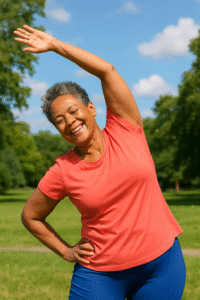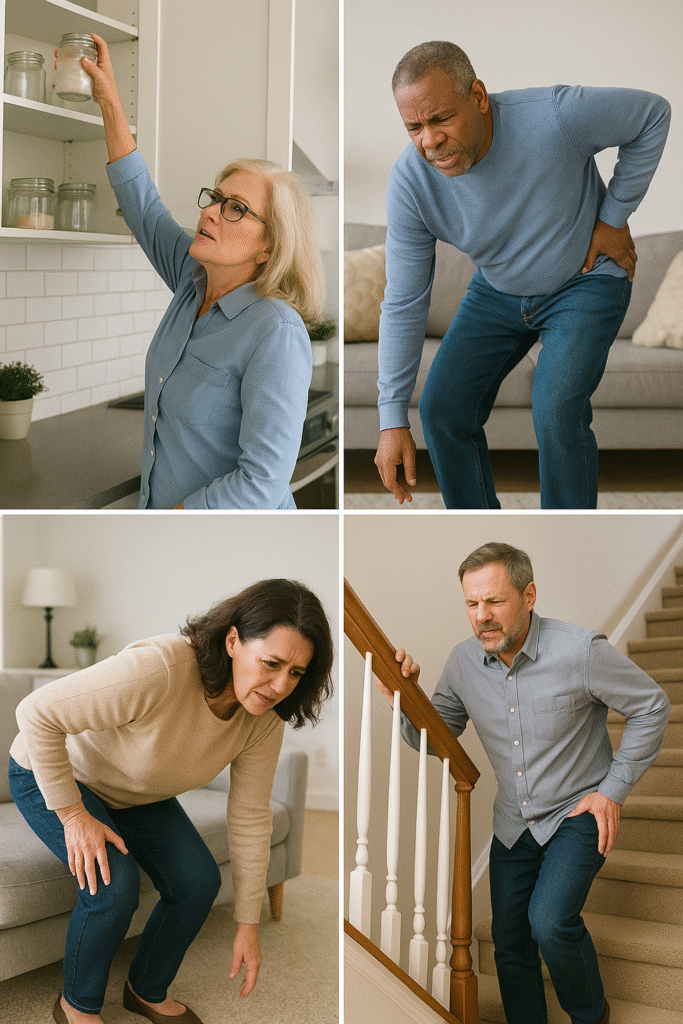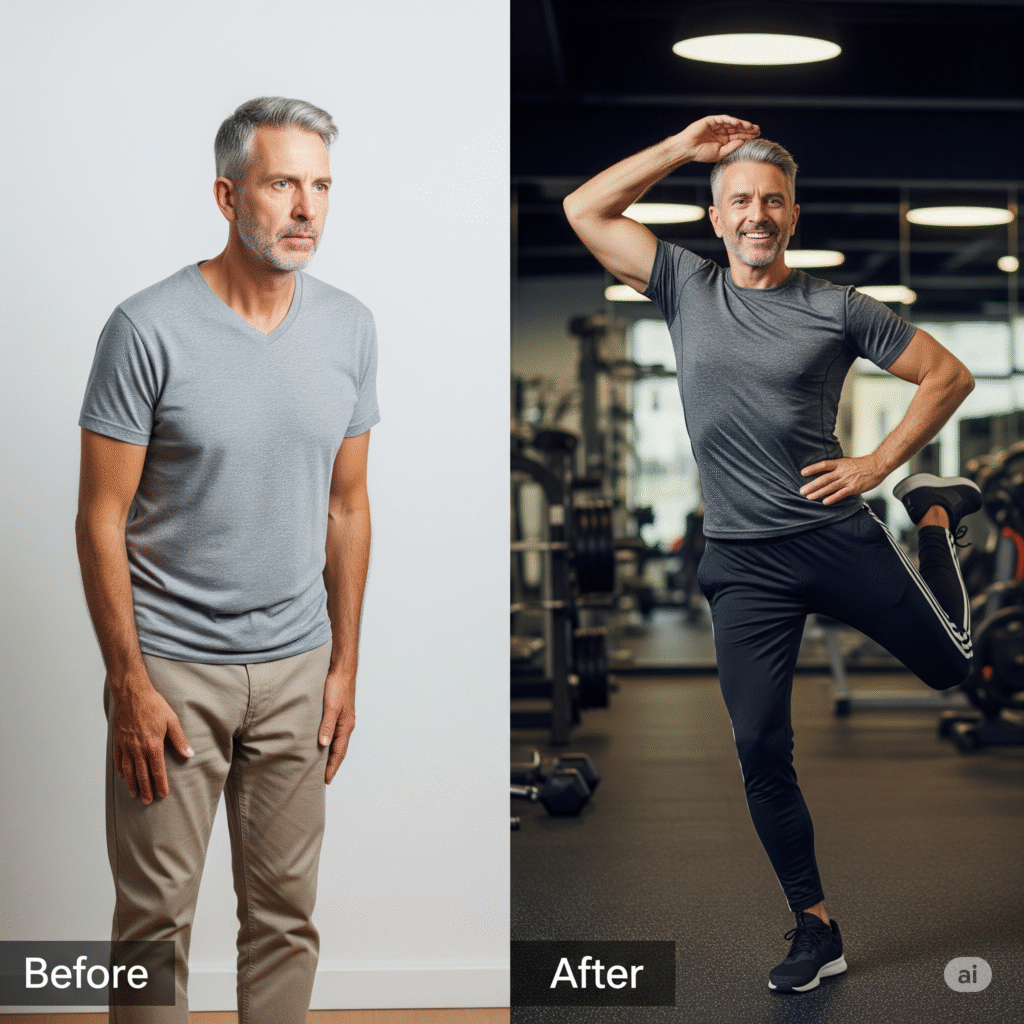Move Freely, Live Fully
Your GoAllFit Guide to Mastering Mobility & Beating Stiffness After 40
Are you in your 40s or beyond and noticing little changes? Maybe that morning stiffness takes longer to work out? Does getting off the floor feel a bit less effortless than it used to? Or perhaps reaching for something high or turning your head while driving feels… well, different?
If you’re nodding along, you’re absolutely not alone. The truth is, our bodies do change as we enter and move through our fabulous forties and fifties. While wisdom and experience increase, many of us start to notice unwelcome shifts in how freely and comfortably we move.
It’s easy to brush these changes off as “just getting older,” but ignoring them can mean missing out on the active, fulfilling life you want to live. At GoAllFit, we believe that mobility isn’t just about how your limbs move; it’s about maintaining your independence, energy, and quality of life for decades to come.
This isn’t about fighting aging – it’s about aging powerfully and proactively.
In this guide, we’ll dive into:
- WHY your mobility might be changing after 40 (it’s more than just age!).
- The frustrating DAILY PAIN POINTS these changes create.
- Proven, actionable STRATEGIES to regain flexibility, reduce stiffness, and build strength.
- How GoAllFit can be your partner in mastering your mobility and living fully.
Ready to ditch the stiffness and reclaim your movement freedom? Let’s get started.
The Real Reason Mobility Changes After 40 (It’s Not Just “Getting Old”)
 It’s true, our bodies are undergoing natural shifts as we age, but understanding what these shifts are is the first step to taking control. It’s not simply a switch that flips at 40; it’s a gradual process influenced by many factors, including how we’ve lived and how we care for our bodies now.
It’s true, our bodies are undergoing natural shifts as we age, but understanding what these shifts are is the first step to taking control. It’s not simply a switch that flips at 40; it’s a gradual process influenced by many factors, including how we’ve lived and how we care for our bodies now.
Here’s a look inside at what’s happening:
- Muscle Power Down (Sarcopenia): You might start losing muscle mass and strength as early as your 30s! This isn’t just about looking less toned; less muscle means less support for your joints, increased fatigue, and reduced power needed for quick movements (like catching yourself if you stumble). This process, called sarcopenia, makes it harder to stay strong and prevent muscle loss after 40.
- Joint Wear & Tear: The smooth cartilage cushioning your joints can thin over time. Your joint’s natural lubricant (synovial fluid) can also decrease or change consistency. Think of it like an engine running with low oil – increased friction, stiffness, and that familiar “grindy” feeling often associated with conditions like osteoarthritis. Many people search for how to improve joint lubrication naturally.
- Connective Tissues Stiffen: Ligaments and tendons (which connect bones to bones and muscles to bones) become less elastic. Fascia, the web connecting everything, can also stiffen. This collective tightening contributes significantly to that overall feeling of stiffness and limited range of motion. Learning stretches for tight connective tissue becomes essential.
- The Brain-Body Connection Changes: Your balance system, coordination, and your body’s sense of where it is in space (proprioception) can become less sharp. This impacts stability and reaction time, making balance exercises for adults over 40 crucial for preventing falls.
These internal shifts are natural, yes, but their impact on your daily life is NOT something you have to accept passively.
Your Daily Pain Points: When Simple Tasks Become Frustrating Hurdles
 These internal changes show up as real-world frustrations. You’re not just “feeling old”; you’re experiencing genuine physical challenges that impact your quality of life. We hear it from our GoAllFit community all the time:
These internal changes show up as real-world frustrations. You’re not just “feeling old”; you’re experiencing genuine physical challenges that impact your quality of life. We hear it from our GoAllFit community all the time:
- Morning Stiffness & Aches: Waking up feeling stiff and needing time to “get going.” (morning stiffness relief for over 40s)
- Difficulty with Basics: Tasks like putting on socks and shoes requiring unexpected effort. (why is it hard to put on socks as I get older?) Getting out of low chairs becoming a struggle. Climbing stairs causing knee pain. (knee pain solutions when climbing stairs)
- Hobbies Feel Harder: Gardening, playing sports, or even just keeping up with grandkids becomes less enjoyable or feels risky due to pain, stiffness, or fatigue.
- Workout Woes: Feeling like recovery takes forever, noticing increased susceptibility to minor injuries, and struggling to maintain fitness levels. (why do I get injured more easily in my 40s?)
- Feeling Stuck: As one member shared, transforming from feeling “flexible and strong” to feeling “totally sedentary, stiff, and weak.”
These challenges aren’t just physical; they can impact your confidence, independence, and emotional well-being. It’s frustrating when your body doesn’t seem to cooperate like it used to.
 Many in our community express surprise and frustration: “I’ve always been active, but this past year I’ve noticed my shape changing, and I just don’t recover from workouts like I used to… It’s VERY upsetting.” Or, “It sucks getting older sometimes! I usually consider it a good gym session if I walk out without a new ache or pain!!”
Many in our community express surprise and frustration: “I’ve always been active, but this past year I’ve noticed my shape changing, and I just don’t recover from workouts like I used to… It’s VERY upsetting.” Or, “It sucks getting older sometimes! I usually consider it a good gym session if I walk out without a new ache or pain!!”
Adding to this, existing conditions like osteoarthritis (natural remedies for osteoarthritis knee pain), degenerative disc disease, balance disorders, or even past injuries (speeding up injury recovery after 40) can compound these challenges, creating a cycle where pain leads to inactivity, which then worsens the condition.
But here’s the empowering truth: You can break this cycle!
Finding Your Stride: GoAllFit’s Actionable Strategies for Better Mobility
 The fantastic news is that significant improvements in mobility, flexibility, and strength are absolutely possible after 40. It requires a consistent, multi-faceted approach, and GoAllFit is here to provide the roadmap and support.
The fantastic news is that significant improvements in mobility, flexibility, and strength are absolutely possible after 40. It requires a consistent, multi-faceted approach, and GoAllFit is here to provide the roadmap and support.
Here are the key strategies we recommend:
1. Embrace Movement: Your Body’s Best Friend!
Think of movement not as a chore, but as essential medicine for your joints and muscles. Consistent exercise is the single most powerful tool you have for staying mobile and active in middle age.
- Aerobic Exercise: Aim for at least 150 minutes of moderate activity weekly (brisk walking, swimming, cycling). This boosts heart health, brain function, mood, and helps manage weight, reducing joint stress.
- Strength Training: Non-negotiable for fighting sarcopenia! Work all major muscle groups 2+ days/week. Use weights, bands, or bodyweight. Strength supports joints, improves bone density, boosts metabolism, and enhances balance.
- Flexibility & Mobility: Dedicate time to stretching and dynamic movements. Focus on areas prone to stiffness (hips, back, shoulders, ankles). Yoga and Pilates are excellent as they combine flexibility, strength, and balance. Look for age-appropriate fitness classes for over 40s.
2. Prioritize Recovery: Sleep is Your Secret Weapon
Your body does crucial repair work while you sleep. Aim for 7-9 hours. Poor sleep increases inflammation, pain, and fatigue – all enemies of good mobility. Make sleep a priority!
3. Fuel Your Body Right: Nutrition for Movement
Focus on lean protein for muscle repair, healthy fats (especially Omega-3s) for their anti-inflammatory benefits, and plenty of colorful fruits and vegetables for vitamins and antioxidants. Don’t forget calcium and Vitamin D for bone health and staying well-hydrated to support connective tissues.
4. Targeted Mobility Work: Pinpoint Your Stiff Spots
Beyond general flexibility, work on specific areas that impact daily function: * Hip openers for easier bending and sitting/standing. * Ankle flexibility for better balance and gait. * Thoracic spine mobility for improved posture and reaching. * Balance exercises (standing on one leg, heel-to-toe walking) are crucial for fall prevention.
5. Listen & Adapt: Your Body Gives You Clues
Aging bodies recover differently. Learn the difference between muscle soreness and joint pain. Don’t push through sharp pain. Modify exercises as needed. Be patient with yourself and celebrate progress – even small gains in flexibility or strength make a difference!
When to Seek Expert Help
 While lifestyle changes go a long way, sometimes you need professional support. Consult a doctor or physical therapist if you experience:
While lifestyle changes go a long way, sometimes you need professional support. Consult a doctor or physical therapist if you experience:
- Persistent or worsening pain.
- Sudden loss of mobility or weakness.
- Suspected injury.
- Existing medical conditions impacting mobility (arthritis, neuropathy, etc.).
- Significant difficulty with daily tasks.
A physical therapist can provide a personalized assessment and exercise plan. A certified personal trainer experienced with older adults can build a safe, effective fitness routine tailored to you. Our GoAllFit advice is designed to work alongside the guidance of your healthcare team.
Your GoAllFit Journey to Effortless Movement
At GoAllFit, we understand these challenges intimately. We’re passionate about empowering you to maintain your mobility and independence. Our programs and resources are designed for your stage of life, providing:
- Age-Appropriate Training: Safe, effective exercises focused on functional strength, flexibility, and balance.
- Expert Guidance: Clear instructions and modifications for all levels.
- Supportive Community: Connect with others on a similar path.
- Holistic Approach: Integrating movement, nutrition, recovery, and mindset.
You don’t have to accept stiffness and limited movement as an inevitable part of aging. By taking proactive steps now, you can significantly impact your quality of life for years to come.
Mastering mobility after 40 is about embracing the journey, being consistent, and knowing you have the tools and support to move freely and live fully.
Ready to take control of your mobility?
Explore GoAllFit’s tailored resources and join our community today!